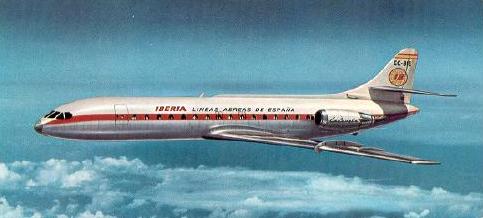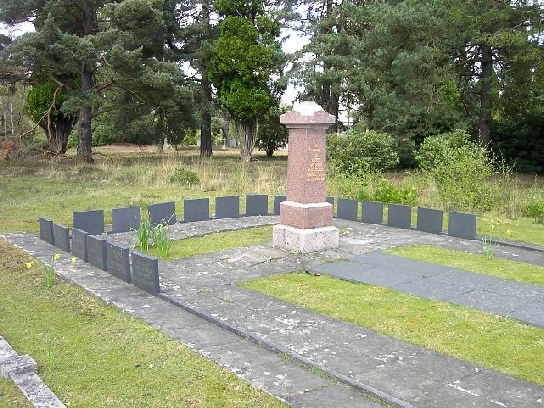

© John Clarke 2014-
John Clarke
Historian of Brookwood Cemetery

The Fernhurst Air Disaster: 50 Years On
At about 10.02pm on the night of Saturday 4 November 1967 a Caravelle airliner owned by the Spanish national airline Iberia Airlines, No. EC-
The aircraft was on a scheduled flight, number IB062, from Malaga to London Heathrow and had been cleared to descend to 6,000 feet on its approach to Heathrow Airport. With no hint of an emergency or in-

A Caravelle airliner of Iberia Airlines
The aircraft was piloted by Captain Harnando Maura [Pieres], aged 37, who was an experienced pilot with Iberia Airlines. The plane had left Malaga at 7.30pm and was expected to arrive at Heathrow around 10.10pm. The weather on that fateful night was described as “slightly misty with intermittent drizzle but there was reasonable visibility” [2]
The Caravelle, named Jesus Guridi, initially struck tress in the grounds of Blackdown House before ploughing across a meadow killing a number of sheep. The aircraft then broke apart destroying a garage and damaging part of the roof of Upper Blackdown House. According to Flight International, the wreckage was “spread in a narrow swath some 800 yards long and was compatible with the aircraft having struck in a near-
The fire brigade at Haslemere was alerted within minutes of the crash as spilt aviation fuel had caused numerous small fires within the wooded hillside of Blackdown. The local fire brigade was joined by those from Grayshott, Liphook and Guildford during the course of the night. It soon became clear that there were no survivors. In the immediate aftermath of the disaster, the Village Hall at Fernhurst was turned into a temporary mortuary. [4]
Despite a lengthy investigation no definite cause could be determined for the crew’s continued descent through their assigned altitude. However, the report conjectured that the crew, being busy with their approach and landing checks, may have misread their altimeter, which was of a type using a combination of pointers and shaded windows and not easy to interpret at a glance:
“The aircraft was fitted with three pointer altimeters with warnings to indicate when the aircraft was below 10,000ft. The aircraft descended continuously at a steady rate over a period of 13½ minutes and the pointers would have been in continuous motion throughout, increasing the likelihood of misreading. The cross hatching in this type of altimeter first appears in a window in the 10,000ft disc at an indicated altitude of 26,666ft and the edge of the cross hatching would have been visible within 2 minutes of the aircraft beginning its descent. At 10,000 feet the cross hatching completely fills the window and it remains filled as long as the aircraft is below 10,000ft. Thus the cross hatching would have been visible to the crew for a period of about 9½ minutes before the aircraft passed through FL60 [6,000ft]. According to the investigation report, it is not difficult to read an indication of 6,000ft as 16,000ft with this type of altimeter if particular note is not made of the position of the 10,000ft pointer. Evidence against the possibility of a simple misreading of this sort is the message from the aircraft to ATC [Air Traffic Control] reporting passing FL145 [14,500ft] indicating that at this time the crew knew that they were below 16,000ft.” [2]
Indeed, there had been several recent accidents where crews were thought to have mistakenly read thousands of feet when their altimeters were actually reading in hundreds of feet. As the Caravelle was flying in the dark, and mostly above a low lying bank of cloud, the crew would have had no visual clues that they were too low until the last moment. In its consideration of the “initial and necessarily superficial evidence”, Flight International came to a similar conclusion. In its brief account of the accident which was published on 9 November 1967 it stated that: “It is reasonable to assume that either the altimeters were inaccurate or were misread by a margin of 10,000ft”. [3] Since there was no subsequent evidence the altimeters were faulty, the only other explanation was that they were misread, although the reasons for this remain unclear.
Soon after the accident most airlines replaced this particular type of altimeter with models which were easier to read. The air accident report concluded that, “The accident was due to the aircraft having continued to descend through its assigned flight level down to the ground. No reason could be established for the continued descent.” [2]

The large plot at Brookwood features a pink granite pedestal memorial inscribed with the words “In memory of the nineteen who died in an air accident, Fernhurst, Sussex, 4th November 1967”. This monument is surrounded on three sides by 19 low slate headstones, each inscribed with the name, date and place of birth of each of the deceased buried in the communal grave. Twelve passenger and six of the crew are buried elsewhere. Surprisingly, one of the Spanish air stewardesses, Miss Araceli Casanova, is buried alongside 16 British and two Spanish passengers at Brookwood.
One of the passengers, Donald Campbell, was well-
The full list if those buried in the plot is:
Archibald Thomas Thain Alexander, born Rugby, 1926
William James Barrett, born Cleethorpes, 1897
Constance Barrett, born Horncastle, 1900
Susan Rosemary Bell, born London, 1917
Araceli Cedillo Casanova, born Madrid, 1933
Donald Campbell, born Dumbarton, 1918
Lilian Campbell, born Bradford, 1917
John Clarkson, born Coventry, ?1942?
Katie Clarkson, born Coventry, 1964
Paula Clarkson, born Blackdown, 1963
Rosemary Clarkson, born Coventry, 1942
Charles Douglas Griffiths, born Nice, 1906
Viola Maclean Griffiths, born Irvine, 1910
Josefa Moya Martin, born Alhama de Granada, 1903
Anita June Peer, born London, 1939
Golda Peer, born London, 1911
Simon Nicholas Crane Richardson, born St Albans, 1946
Francisco Herrera Santos, born Mallorca, 1934
Barry Markham Thomas, born London, 1943
The central granite memorial replaced the original grey-
On the 50th anniversary of this air disaster, over the weekend of the 4-
Notes and sources
[1] The accident is now the eleventh worst air accident in Britain.
[2] Accident description from the Aviation Safety Network
[3] “Caravelle 10,000ft too low” Flight International, 9 November 1967, p.749.
[4] “Experts baffled by Caravelle air crash”, The Times, 6 November 1967.
“Fatal air crash remembered” Haslemere Herald, 12 November 2017.
The Fernhurst Society at http://www.fernhurstsociety.org.uk
“Horrific air crash on Blackdown is remembered” Midhurst & Petworth Observer, 1 November 2017.
“Villagers set to commemorate 1967 air crash” Haslemere Herald, 27 October 2017.42
Copyright © 2017 by John M. Clarke All Rights Reserved